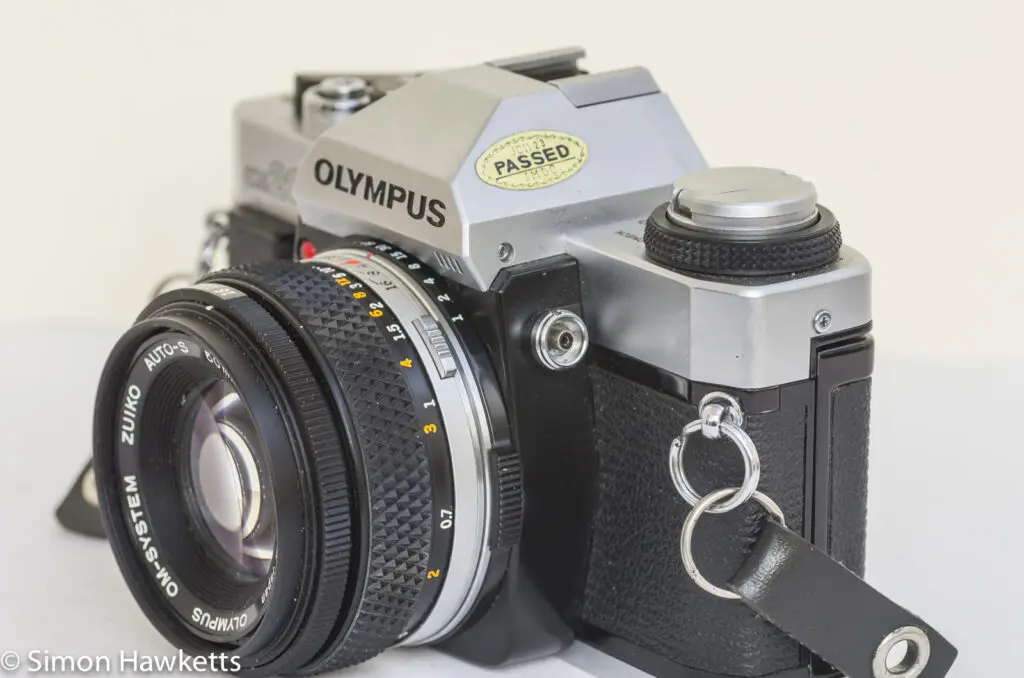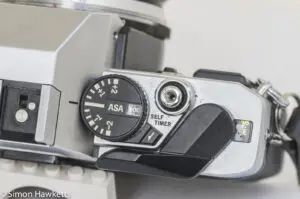Olympus OM-20 35 mm SLR review
This is my review of the Olympus OM-20 35 mm single lens reflex camera which was made about 1983 and was, for a long time, the camera I used for all my photography.
Olympus OM-20 Images













My Olympus OM-20 Camera
I have to say, this is a review that I’ve been wanting to write for a long time but couldn’t because I didn’t own an OM-20.
Let me explain – I bought an Olympus OM-20 when they originally came out, sometime in the early 1980s. I’d just started work at Marconi Instruments in St Albans, and could afford to buy a ‘good’ camera to replace my aged Petri MF-1. The one I really wanted to get was the Olympus OM-2, but that was just too expensive, so I settled on an OM-20 with a 50 mm f/1.4 lens instead.
I used that camera for many years, adding a Hanimex 28 mm wide angle and 70-210 mm zoom, until about 1995 when I upgraded to an autofocus Canon EOS 300 and traded the whole OM-20 kit in. At the time it seemed to be the sensible thing to do because I got a few pounds for it (probably about £50 I guess), but after a few years or so I wished I’d kept it.
Well, since I started collecting vintage cameras I’ve been on the lookout for an Olympus OM-20, but I never found one at the same time that I had funds available to buy it, and anyway I never found a reasonably priced one. The Olympus OM series really hold their value, with the single digit versions like the OM-1 and OM-2 selling for £50 to £100 still and even the consumer OM-10/20/30/40 models being quite expensive.
Last week, however, I found what I’ve been looking for – an OM-20 complete with 50 mm f/1.8 lens which was sold as untested and therefore starting at a low price, but which looked in very good cosmetic condition. I waited till the last few seconds to bid and managed to get it for only £9.63.
When the camera turned up I was pleased to see that it was in virtually perfect cosmetic condition with only a couple of light marks on the top chrome section and some scuffing on the black back panel. I was also surprised to find that when I turned the main switch to ‘check’ the camera beeped and the front LED lit up – the battery is still OK!
After a bit of playing around with the camera, I found just about everything is working as expected. The exposure meter seems accurate, the shutter speeds seem fine, and all the controls work without problem. The only issue I’ve found is with the lens – the aperture blades are a bit sticky and have a delay in opening up after a shot. It’s not really noticeable if the aperture is stopped down quite a lot because there seems to be enough energy to open the blades again, but if the aperture is only f/4 for example it takes a few seconds to open up. I’m going to have to open the lens up and see if I can clean the blades.
Update: As it happens, I didn’t have to open the lens – after a week or so of sitting in a warm room, the blades sorted themselves out and now close quite easily. I’ll need to check they still work when I’m out on a cold day, however!
Olympus OM-20 Description
The Olympus OM-20 was made as a consumer version of the very popular Olympus OM cameras, which were introduced in the mid 1970s.
Olympus were late in producing a 35 mm SLR, but were trend setters when they came up with their OM-1 model. They produced a compact, quite, good quality camera which was an immediate success with consumers, and lead to a general trend to produce smaller, lighter cameras. The original model, the OM-1, was a mechanical camera with no automation, and it was followed by the OM-2 which added aperture priority auto exposure.
Because of the success of these professional class cameras, Olympus brought out slightly lower spec models aimed at serious amateur photographers, and these were the 10, 20, 30 and 40 models. This unit, the OM-20, is similar to the OM-2 in that it has aperture priority auto exposure as well as manual exposure.
Along with the camera bodies, there was also a comprehensive set of lenses and other accessories to go with the OM series, and the lenses in particular had a reputation for being really high quality.
I find the camera nice to use with controls in convenient places – for example, the shutter speed is set by a dial round the back of the lens mount. Since your hand is in that position to focus and set the aperture, it is pretty well-placed to also set the shutter speed.
Metering
I remember reading at the time the OM series were first introduced how advanced the metering was. I suspect that compared to today the metering is not very special, but for its day it was considered extremely accurate. I think the thing which most impressed me was the fact that the metering works by measuring the light reflected off the film plane at the point the exposure was made, rather than metering on the light entering the lens as most cameras do.
I actually confirmed that this is how the exposure metering works by checking the shutter speed the camera uses in auto mode without a film and then checking again with the film door open and a sheet of white paper held against the back of the shutter where the film would be. Sure enough, when the white paper was in place, the shutter speed was faster (more light is reflected off the white paper than the black pressure plate).
Of course, I don’t know if measuring the light off the film is actually intrinsically a more accurate system, or if it was just a marketing trick, but I know I was impressed at the time!
For situations where there is significant back lighting or the picture is being taken into the sun, there are +/- 2 stops of exposure compensation available on the dedicated exposure compensation dial next to the shutter release.
Exposure modes & Viewfinder
As I said above, the OM-20 offers aperture priority auto exposure and full manual mode. These modes are selected with the main on/off switch on the top plate, which is mounted around the rewind crank.
Something which surprised me when I tried the camera out recently, and which I don’t think I was aware of when I first owned an OM-20 in the 1980s, is the fact that the camera is never actually off. If you pick it up when switched off and take a picture, it actually functions in auto exposure mode. Initially I thought this was a fault with my camera, but a bit of research suggests it was a feature which Olympus built in so that the camera was always ready to take a picture.
What I found out is that the off position on the switch just limits the shutter speed to 1/30th or faster to save on battery power, but my experience with my camera suggests that isn’t the case. I found the shutter would run much slower than that, with the shutter being open for up to 16 seconds when a small aperture was used in almost dark conditions. The one thing that is different in ‘off’ mode is that the viewfinder LED’s don’t show.
In aperture priority mode, the shutter speed chosen by the camera is displayed in the viewfinder as LED numerals, so the photographer is kept well-informed. If there is too much light, the word ‘OVER’ is displayed in red at the top of the left-hand side and there is another indicator at the bottom of the left-hand side which lights if exposure compensation is enabled.
In manual mode, the number on the left-hand side of the viewfinder will show the shutter speed the camera is suggesting, but it doesn’t display the actual shutter speed selected. That is a bit of an inconvenience because you need to remove the camera from your eye to set the shutter speed, although you can improve matters by selecting the shutter speed and then set the aperture until the speed the camera suggests is the speed you have already selected.
Because this is a manual focus camera, there are better focusing aids than are found in autofocus cameras, and this means a split rangefinder is available in the centre of the viewfinder, with a micro prism surrounding it. I find it a pretty good combination, although the focus screen on my camera is a bit dirty.
I was surprised to find when I investigated cleaning it that the focus screen looks as if it is replaceable. Although that was not an advertised feature on the OM-20, careful examination of the screen shows it is held in by a springy clip, and if that is unhooked with tweezers it’s possible to lift the screen out. I must point out that I haven’t tried it yet because I want to get some plastic tweezers, so I don’t scratch the screen, but it certainly looks removable.
Olympus OM-20 features and specifications
As well as a hot shoe flash socket, there is a sync socket fitted to the side of the camera to wire up an external flash. There is provision for fitting a motor drive to the camera, and there is a bolt on grip fitted to the front which makes the camera easier to hold.
The self-timer is fully electronic and operated by a switch next to the shutter release button. As well as beeping, the battery check LED on the front of the camera flashes as the self-timer counts down, so it would be impossible to miss.
Although this isn’t the camera I originally owned in the 1980s, buying this one brings back memories of days I spent taking photo’s with my original camera.
- Olympus OM-20 35mm manual focus SLR
- Aperture priority auto exposure and manual exposure
- Metering carried out by measuring light reflected off the film
- 1 sec to 1/1000 + B shutter in manual mode – extended in auto mode
- +/- 2 stops exposure compensation
- ASA range 25 to 1600
- Powered by two SR44 batteries (easily available)
- Electronic self timer approx 10 sec
- OM bayonet mount lens
- Motor drive available
- Split rangefinder focusing aid
- Shutter speeds indicated in viewfinder
- Convenient control layout
- Hot shoe and flash sync socket
- Body Ser No: 1012650
- Lens Ser No: 3493815
- Manual available on-line here
Discover more from Everything Vintage
Subscribe to get the latest posts sent to your email.








